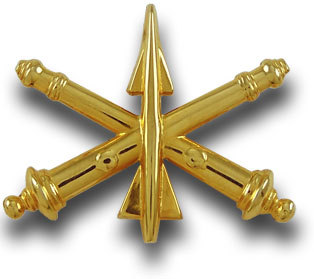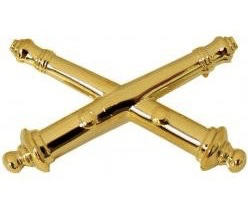Joseph DeFrancisco – Battery Commander – Part three
Divorce Artillery Style
I came home from Vietnam in June of ’68 and went to the advanced artillery course at Ft. Sill, happy that I’m finally going to get to go to artillery school. I get there and that is when I find out the artillery branch had split into two separate branches: Field Artillery (FA) headquartered a Ft. Sill, and Air Defense Artillery (ADA) headquartered at Ft. Bliss, Texas.
Air Defense Artillery encompasses twin 40 mm cannon Dusters, Quad-50 machine guns and searchlights. Field Artillery encompasses all sizes of howitzers. The split between the two became official in 1968 following recommendations dating back to 1963. There had been a longstanding recognition that training officers in the different skillsets for field artillery and air defense served neither well. Attempting to train hybrid FA-ADA officers simply “spawned mediocrity.” The two disciplines already had well developed training centers and a cadre of officers focused on their particular areas, therefore the split largely formalized what had become an operational reality.
Along with the split the brass insignia also changed. The brass insignia I wore in Vietnam, the crossed cannons with the missile in the middle, would become the ADA insignia. And Field Artillery would get its own new insignia, crossed cannons without the missile.
 Original Artillery brass retained by ADA
Original Artillery brass retained by ADA
 New Field Artillery brass
New Field Artillery brass
So we changed brass. Many of the officers who had to change their branch to ADA did not like that idea. People who had a long military background and had grown up in the military got emotional about it. They wanted to be Field Artillery. To them it was a big deal. To me it was not a big deal because I stayed in FA. If I had been assigned to ADA I might have felt differently.
After being in Vietnam for a year my time in FA school at Ft. Sill was a very enjoyable time. Just living in a house with my family. A lot of the people in the course with me I had met and befriended in Vietnam. It was a pleasant year.
Another Soul Searching Decision
At the end of that year it was time to find out where you were going next. They gave me three choices. I could go back to Germany, I could go to Ft. Knox, or I could stay at Ft. Sill. But Field Artillery brass said that no matter where you go, it’s only going to be for a year, and then you’re back in Vietnam. That was a traumatic thing for me and for my wife Lynne to learn. The only remaining option was to get out of the Army.
After a lot of soul searching we decided to stay in the Army. We stayed because at the end of my second tour in Vietnam the Army promised to send me to graduate school for an advanced degree to teach history at West Point, which was something I wanted to do. With that prospect in mind Lynne very courageously said, OK, we’ll do another year. At the time we had been married about five years. We celebrated our 50th wedding anniversary in November 2015. Over the years she has been an important part of everything I’ve done.
Tough Duty
We opted to stay at Ft. Sill after artillery school. I had the further choice to become an instructor or go to a unit and I said, I’ll go to a unit. I became a battery commander in a 105 mm howitzer battalion. By the way, that was a B Battery also, 4th Battalion of the 14th Field Artillery Regiment. It was a FORSCOM battalion, so we had to go through all the FC tests.
United States Army Forces Command (FORSCOM) was a four-star general Army command whose mission was, and is still today, to prepare units across various Army branches and their families for immediate deployment anywhere in the world.
And we also shot in support of training at the artillery school. This assignment turned out to be a real leadership challenge. The war was immensely unpopular and anti-war sentiment was high. This was also the time when race riots were predominant throughout the country. Not at Ft. Sill, but my battery was about 40% African American – “black” in the vernacular of the day – and we still had a lot of racial problems. On top of that we had a lot of drug problems.
Most of the young troops in the battalion had been drafted, went through basic, went to Vietnam, and still had six to eight months left on their enlistment. Many thought they had done their share for their country by serving in Vietnam and now just wanted to get out of the Army and go home. This group had no interest in doing any more military duty, consequently some got themselves in real trouble.
Every Saturday morning I’d go visit my troops in the brig; I always had six or seven troops in jail. There were always just a few bad apples. The brig was right next to the battalion area. I’d just walk down there on a Saturday morning to see how they were doing. Even though they were in prison I had to take care of troops assigned to me. I’d see how they were doing, make sure they were being treated alright, see if they needed anything in terms of contacting relatives, checking on their medical condition. Once in awhile I would talk to them about the seriousness of their situation. How are you going to overcome this? What kind of job might you do when you get out of the Army? Most of these guys did not want to talk. When an offense was bad enough for the young men to go to Leavenworth of course they were off my books. But when they were locals, serving two weeks, thirty days, ninety days – they were still mine, still part of my roster. That part of the job was not at all happy.
Overall it was a tough assignment and a lot of hard work. In addition to the FORSCOM tests, the artillery school graded us on every exercise we shot for them. You were graded on how well your troops supported the training objectives, having the right equipment and commo gear, logistical coordination – all of this with troops most of whom did not want to be there. It was a pretty demanding job. After a year the branch was good to its word and assigned me to Vietnam.



